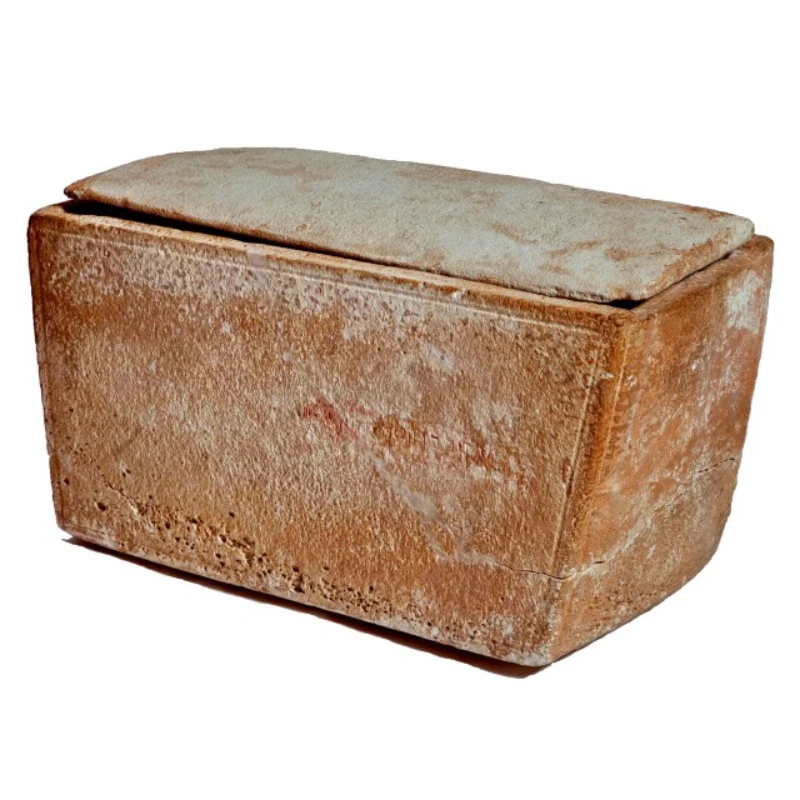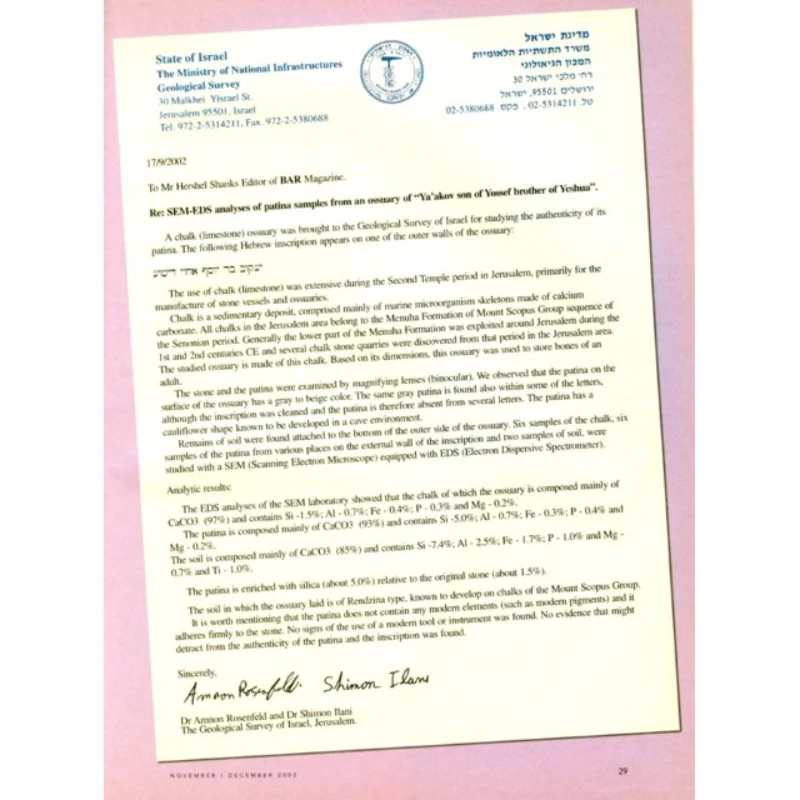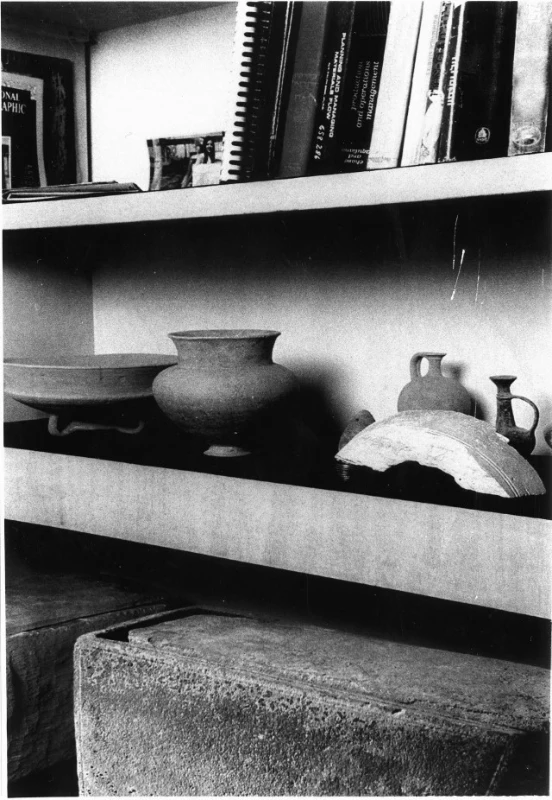The James Ossuary
Ya’acov (James), son of Joseph, Brother of Yeshua (Jesus) ossuary
יעקוב בר יוסף אחוי דישוע


Ya’acov (James), son of Joseph, Brother of Yeshua (Jesus) ossuary
יעקוב בר יוסף אחוי דישוע


The James Ossuary is a first century AD limestone ossuary (bone-box) bearing the Aramaic inscription: "Ya'akov Bar Yosef Achui DeYeshua" (= Ya'akov, son of Joseph, Brother of Jesus).
This inscription constitutes the earliest known archaeological reference to Jesus of Nazareth, and the only artifact ever discovered that can be directly attributed to a member of Jesus’ family. Its significance is therefore unparalleled in the study of early Christianity and Jewish history.
Historical Background
The ossuary was most likely used as the final resting place of the skeletal remains of Ya'akov (James), the brother of Jesus of Nazareth. James was also known as "James the Just," St. James, and in Spanish tradition San Diego. He is mentioned both in the New Testament and by the first century historian Josephus Flavius (Antiquities of the Jews).
James served as the head of the Judeo-Christian community in Jerusalem around 37 AD, and is regarded as the first bishop of Jerusalem. He was executed by stoning at the order of the Sanhedrin in 63 AD.

Discovery and Identification
The James Ossuary was reportedly discovered in Silwan, East Jerusalem, and sold in the mid-1970s in the local antiquities market by a licensed Palestinian dealer. It reached an Israeli antiquities collector without recognition of its importance.
In 2000, the ossuary was examined by Prof. André Lemaire (Sorbonne University, expert in Hebrew and Aramaic), who identified that the ossuary should most likely be attributed to Ya'acov (James), the brother of Jesus. He published his findings in Biblical Archaeology Review (BAR), after which the ossuary was exhibited in a special display at the Royal Ontario Museum (ROM) in Toronto in 2002.
Rarity of the Name Combination
Each of the names inscribed (Ya’acov, Yoseph, Yeshua) was common among Jewish men in first-century Jerusalem. However, the combination of all three names - a father named Yoseph, one son named Ya’acov, and another named Yeshua - is exceedingly rare.
This drastically increases the probability of associating the ossuary with James, son of Joseph (husband of Mary), and brother of Jesus of Nazareth.

Scientific and Scholarly Examination
The ossuary and its inscription were independently examined by a wide range of international experts across multiple disciplines, including geology, geo-microbiology, patina, stone, engraving technologies, archaeology, paleography, isotopy, ancient names, and statistics.
Among those who examined the ossuary were:
And others.
The consensus of these experts was that the inscription is authentic and dates to the first half of the first century AD.
Scientific Tests and Patina Analysis
Microscopic photography and laboratory testing demonstrated conclusively that a natural patina had developed inside the grooves of the inscription over many centuries.
Microorganisms (bacteria) living on the stone while it was in the burial cave created a biological patina layer, which over time became an integral part of the stone. This patina was identified inside the grooves of multiple letters.
Patina, formed by the biological activity of bacteria on stone surfaces, develops naturally, gradually, and over long periods – and cannot be artificially produced without being exposed by scientific testing.
In a comprehensive verdict delivered by the Jerusalem District Court on March 12, 2012 (Criminal Case 482/04), Judge Aharon Farkash ruled that biological patina had been identified inside the grooves of the inscription, including in the word “Yeshua” (“Jesus”), with isotopic composition consistent with an ancient inscription. He accepted Prof. Krumbein’s conclusion that “the patina on the ossuary developed over hundreds, if not thousands, of years, and that the patina within the inscription and the patina on the ossuary were formed during the same period of time.”
The State did not appeal this verdict. The presence of bio-patina is considered decisive scientific proof that the inscription is ancient and not a modern addition.
The State did not appeal this verdict.
The presence of bio-patina is considered decisive scientific proof that the inscription is ancient and not a modern addition.


Statistical Analysis
Prof. Camil Fuchs (Tel Aviv University) conducted a statistical study based on the distribution of names in first-century Jerusalem, using hundreds of ossuaries and other historical sources.
He found that, given the combination of names on the James Ossuary, the rarity of sibling references on ossuaries, and population statistics of the relatively short period in which ossuaries were in use, there is close to a 100% probability that the inscription refers specifically to James, the brother of Jesus.
Scholarly Publication and Recognition
The ossuary was formally published in the scientific corpus of ancient inscriptions of Israel: Corpus Inscriptionum Iudaeae / Palaestinae - Volume 1, Jerusalem, Part 1: 1-704. In a 2019 survey conducted by Haaretz (Nir Hasson), Israeli archaeologists ranked the James Ossuary as the most important archaeological discovery in Israel in the last 70 years.
Conclusion
The James Ossuary stands as one of the most extraordinary artifacts ever discovered in the Land of Israel:
This convergence of textual, scientific, statistical, and historical evidence establishes the James Ossuary as a discovery of singular importance to both biblical archaeology and world history.
References:

